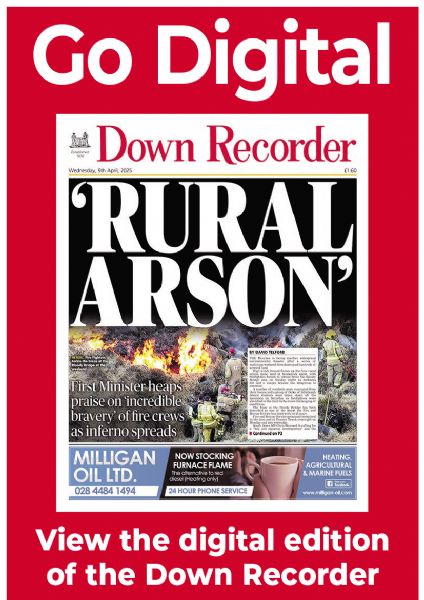Ancient jewellery ruled as treasure by coroner
Ancient jewellery ruled as treasure by coroner
17 August 2016
ARTEFACTS dating from Viking times to the reign of Mary I have been declared treasure after they were found by local metal detecting enthusiasts.
Coroner Suzanne Anderson made the rulings at Downpatrick Court on Thursday at a special Treasure Trove inquest.
There are a number of conditions that have to be met before a court can declare a find ‘treasure’, such as the item being over 300 years old. The percentage of precious metal is also considered.
The first item to be brought before the court for assessment was a hoard of 12 silver coins found on the beach at Ballyhornan in July 2014 by Ardglass man Philip Sutcliffe.
They are all groats, or four penny pieces, issued in the name of Queen Mary and her husband Philip II of Spain between 1555 and 1558.
The court heard it was likely the coins were on top of each other as a stack when they were lost or buried. A comparatively low silver content of around 25 to 30 per cent likely contributed to the poor condition of the coins, which show extensive corrosion.
A report by Robert Heslip, from National Museums Northern Ireland, was submitted to the court, explaining that the coins had undergone expert x-ray analysis.
“Coins issued by Philip and Mary for Ireland had a lower silver content than would have been the norm,” said a museum spokesman. “This deliberate act of ‘debasement’ reduced the precious metal content allowing more coins to be produced and saved on silver, while hoping the coins would retain their face value.
“Queen Elizabeth I, who succeeded Mary in 1588, set about restoring the sterling standard of silver coins in England and issued coins in her own name in 1559. Since none of these seems to be present, it might suggest the probability that the coins in this hoard were concealed or lost before or soon after this date.”
Mr Sutcliffe told the court he had been using metal detecting as a relaxing hobby. He said he knew only that what he had discovered was very old and approached Down County Museum for guidance.
“I didn’t know what they were,” he told the court.
Landowner Patrick Magee explained that while he had not given permission for the search, this part of the beach was widely used by members of the public.
Coroner Suzanne Anderson told Mr Sutcliffe: “Congratulations on a very interesting find.”
A Viking silver arm-ring, found by local man Peter Quinn in March 2015, was the next item considered. This was found in two pieces near Myra Castle in the Downpatrick townland of Walshestown, at the southern end of Strangford Lough. Undecorated, it weighs just under 20 grams.
Dating back to around 900AD, the court heard these items were manufactured primarily as a form of currency but likely also served as status objects, worn as items of jewellery. At least 140 examples are on record from Ireland and the type is also represented in finds from Britain, Norway and Denmark.
Dr Greer Ramsey, Archaeology Curator for National Museums Northern Ireland, gave details of an examination had been carried out by University College Cork.
“X-ray forensic testing showed it was 94 per cent silver in keeping with other Viking silver objects from Northern Ireland,” he said.
Dr Ramsey went on to say the presence of a Viking arm-ring in the vicinity of Downpatrick was not unexpected. As well as the first recorded Viking raid taking place on Rathlin Island on 795, he told the court Downpatrick and Bangor were attacked on several occasions during the ninth and tenth centuries. He also pointed to a likely Viking naval base at Strangford Lough.
“Metal detecting is just a hobby when I have free time,” said 28 year-old finder Mr Quinn, who works as a foreman when he is not discovering treasure.
“I thought it was a piece of scrap metal so had no plans in reporting it.”
Mr Quinn said a friend going through his collection suggested it might be worth looking into.
Landowner Michael Good also told the coroner it was the first find of this nature.
“We were amazed it could have any value attached to it at all,” he said.
A tiny mediaeval gold ring brooch, found in a field at Carrowdressex near Ardglass in October last year was the final item presented at the Treasure Trove hearing. The landowner is retired farmer Harry Fitzpatrick, who said nothing else of interest had been found since.
Finder Ryan Walsh explained that barley had grown up through the ring brooch, pushing it out of the ground.
Dating from the 14th century, the surface of the ring is decorated with two sets of floral motifs.
Projecting at an angle from the circle is what would originally have been two opposing hands, as if they were joined in prayer. Dr Ramsey explained that hands are now open as a result of the ring’s surface being flattened.
He added such pieces of jewellery were worn by men and women for decorative purposes.
“It is 74 per cent gold,” he said. “This is the equivalent of 18 carat gold.”
Dr Ramsey said the ring was found in the vicinity of two church sites mentioned in the 1300s and a later tower-house of the 15-16th century, but no clear relationship between them or any burial ground could be established.
“At one stage this would have been quite a treasured item,” he said. “Somebody could have been working in the fields and lost it giving its small size. Once you ped it you could never find it.”
All the treasure presented at Downpatrick Courthouse will now be sent to the British Museum for valuation and then offered to National Museums Northern Ireland.
The value of each item will be split between their finder and the landowner.


